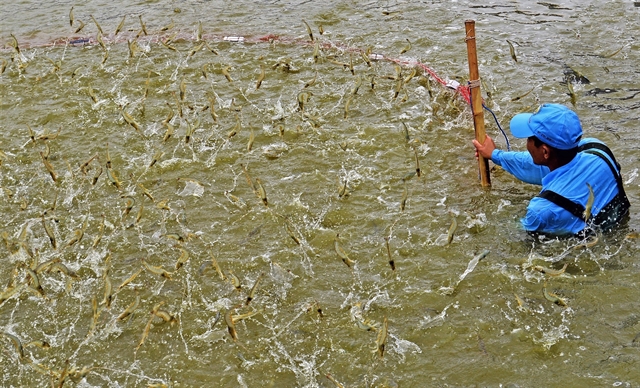 Economy
Economy

 |
| Nguyễn Thị Quyên showing off her plastic box crab farming method. — VNA/VNS Photos Huỳnh Anh |
CÀ MAU — Boldly applying science and technology in aquaculture is earning significant profits for crab farmers in the southernmost province of Cà Mau, where crab is a high-value marine product, second only to shrimp.
Nguyễn Thị Quyên, from Tân Tạo Hamlet in Tân Hưng Đông Commune, Cái Nước District, has become a successful example in aquaculture development with her method of raising crabs in plastic boxes.
Her family's investment in the high-tech crab farming model, featuring plastic boxes and a recirculating water treatment system, allows for continuous monitoring of water quality, temperature and crab health. This enables timely adjustments to maintain an optimal living environment for the crabs.
Sharing the secret to her family's success over five farming seasons, Quyên believes that selecting healthy, robust crabs for farming minimises losses.
The crabs' health and feeding responsiveness are monitored daily through meticulous record-keeping to adjust their diet appropriately.
"Each crab is raised separately in a plastic box for 10 to 40 days, depending on the type of crab. Local food sources for the crabs are readily available, such as small fish, clams and snails," Quyên told Tin Tức newspaper.
For new crab breeders, the initial investment costs can be a significant obstacle.
However, farmers can recoup their profits with each farming cycle. Each batch of crabs can yield profits ranging up to VNĐ7 million (US$273), she said.
At present, with 200 crab boxes, Quyên's family applies a rotational farming method, ensuring that crabs are available for sale every day.
This approach has enabled her family to proactively sell commercial crabs at peak demand times, fetching the highest prices and resulting in profits that at times have increased by over 150 per cent.
More importantly, the model shows that farmers are beginning to apply scientific and technical methods in production, according to Trần Thanh Liêm, Chairman of the Farmers' Association in Tân Hưng Đông Commune.
Compared to traditional crab farming methods, raising crabs in plastic boxes requires farmers to closely monitor everything including water treatment and the health of the crabs, as well as feeding and cleaning the boxes.
Farming crabs in plastic boxes offer a significant advantage in that it requires less land area.
"Farmers can control the number of crabs being raised, manage disease outbreaks and proactively harvest for the highest selling prices," he said.
"Quyên's model of crab farming in plastic boxes has paved the way for new opportunities for women in rural areas."
 |
| Water treatment system for crab farming. |
Quyên's innovative crab farming model has recently secured a VNĐ180 million investment from the Department of Agriculture and Rural Development in Cái Nước District. This financial support aims to advance the development of her pioneering approach.
With its array of benefits, this unique model has garnered significant interest among fellow farmers who visit to learn from Quyên's experience. Similar crab farming models have begun to emerge in localities across the province, all showing promising outcomes.
Crab farming stands as a cornerstone of Cà Mau's aquaculture industry and is a focal point for the agricultural sector's restructuring efforts.
With an extensive annual crab farming area exceeding 250,000 hectares and an estimated yield surpassing 25,000 tons, valued at over VNĐ10 trillion, it serves as a substantial source of income for aquaculture practitioners, coming second only to shrimp products.
Cà Mau leads the nation in crab production. The province's select crab farming regions have obtained geographical indication protection through collective trademark labels.
This strategic move aims to bolster management practices, ensure quality control and fortify product branding.
It also aims to further elevate the value of local crab products, which are considered regional specialties and highly esteemed by domestic and international consumers due to their exceptional quality. — VNS